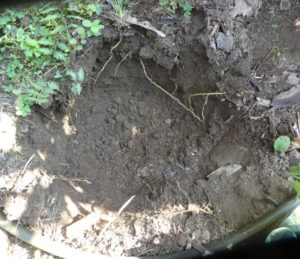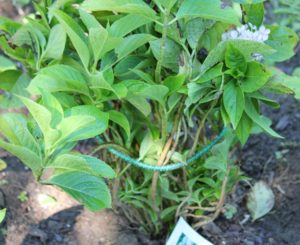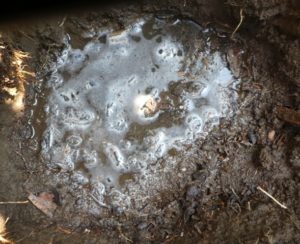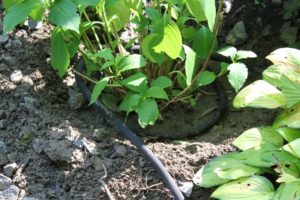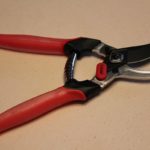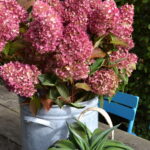I am in the middle of transplanting hydrangeas, a common late season activity for me. Has your hydrangea outgrown its space? Maybe it didn’t flower and needs more sun. Or maybe you need to fill a hole somewhere else in your garden. It could be time to move your hydrangea to a better spot. Let’s go through what you need to do to transplant your hydrangeas in fall vs. spring.
TRANSPLANTING HYDRANGEAS: TIMING
In terms of timing, if you live in a cold zone get the transplanting done at least 6 weeks before the ground freezes in your area.
As an example, my ground usually freezes by about December 1. So that means I need to get my transplanting done by mid-October at the latest. Usually hydrangeas aren’t dormant yet but if I wait until dormancy, my plants won’t have the full six weeks they need to establish roots.
If you are in states/geographies where the ground doesn’t freeze, then you need to wait until your plant goes dormant. The easy way to tell is when it drops its leaves. That signals it’s in a resting/dormant state.
Regardless of where you are, avoid transplanting your hydrangeas in hot weather. Check your local forecast to be sure you are not on the cusp of one of those heat waves. Neither you nor your plants will survive the stress!
TRANSPLANTING HYDRANGEAS: PREPARE THE NEW SITE FOR YOUR TRANSPLANT
Once you have chosen the best site based on your hydrangea’s needs (allowing for sunlight, soil, and moisture conditions), dig the receiving hole first to be sure it can accommodate the rootball. I can’t tell you how many times I have hit “foundation” rocks (read GINORMOUS) that have thwarted my planting plans!
If you’re okay on the receiving end, fill the hole with water and let it drain to be sure your drainage is adequate. If it empties in less than an hour, your hydrangea transplant will either die of thirst or you will be exhausted trying to keep it hydrated. This rapid drainage is an indication that your soil isn’t water-retentive and needs to be amended to hold moisture. Or maybe you need to pick a different site.
If it takes a few hours to empty, you should be okay to transplant your hydrangea into this hole. If it takes a day or more to empty, your soil is much too heavy in that spot. You will need to seriously amend it, or find a better site.
TRANSPLANTING HYDRANGEAS AND AMENDMENTS
You might want to do a soil test to ensure you have the right conditions for your plant. Analyze your results to get clear on what amendments you may have to add to bring that space up to standards.
Transplanting is traumatic for a plant so I always recommend using some sort of mycorrhizae additive in the fill soil. It helps establish roots and reduce transplant shock. Your local independent garden center can guide you to these additives. There are many choices on the market. Simply follow the label directions to help your hydrangea make a successful transition.
The only other amendments to add at transplant time are compost or composted manure and whatever you have decided to apply to adjust the pH, if at all.
PREPARE THE HYDRANGEA THAT YOU’RE TRANSPLANTING
Water the plant the night before moving it to ensure that it is well hydrated. Depending on the size of your plant, a wheelbarrow may be necessary plus some burlap and/or a tarp. A garden buddy for an extra pair of hands and a strong back will also come in handy.
Be aware that some plants can open up and splay once they have been dug completely around their base at the drip line. If your plant is large and you want to keep it that size, wrap it loosely with a bungee cord or somehow tie it to keep it together.
TRANSPLANTING HYDRANGEAS: DIG IT UP!
Carefully use your transplant spade to gently dig around the edges of your plant at the drip line without actually digging it up. Then go deeper and start to coax the plant out of the ground. You are trying to keep as much of the rootball intact as possible. Slide the burlap under the plant and tie it around the rootball to keep it together. Now is when the plant might split, so you want to slide it onto that tarp and avoid actually lifting it. Here’s the moment when your garden buddy can help you as you either drag the plant over to the new hole or lift it into the wheelbarrow for transport.
TRANSPLANTING HYDRANGEAS: MAKE THE MOVE
By now your newly dug planting hole should be ready to accept its new tenant. The water drainage has been tested, the proper amendments have been added based on your soil test, and your plant is good to go.
PUDDLING IT IN
Now “puddle the plant in.” “Puddling in” is a bit of a throwback to your childhood mud-playing days, except now it’s a useful planting technique. Put your plant into the very wet hole that has just finished draining. The hole might even have some water still in the bottom of it—with some of the backfill soil. Then water the plant and the backfill lightly to get a good muddy mix going. Tamp it slightly to remove the air pockets. Let that set for a bit, and then repeat that process until the plant is completely in the ground. It’s OK if there is a bit of water sitting at its crown. That water should slowly percolate down to the roots. This puddling process not only waters the plant well, but also eliminates air pockets during and after backfilling.
Make sure the plant doesn’t sit deeper in its new hole than it was before you moved it. The only exception to this is if the plant had been heaved out of its previous spot for some reason such as burrowing creatures.
Amendments – if at all — like compost should be thoroughly integrated into the backsoil and the planting hole along with the native soil. No peat moss, Holly-tone®, Miracid®, or anything else should be added at this time.
Create a firm soil collar about 2 inches high and about 4 inches out from the base of the plant. This “dam” will capture water and allow it to be slowly absorbed by the soil. Or, better yet, lay a soaker hose a few inches away from the base of the plant so you can just turn it on to ensure your transplant gets off to a good start.
TRANSPLANTING HYDRANGEAS AND MULCH
The last part of the transplant process is to mulch your newly transplanted hydrangea. You want to put down a 2- to 4-inch layer of mulch. Wood chips, shredded leaves, cedar mulch, etc. will all work fine. The kind of hydrangea you have and where you moved it to will determine the proper mulch. There is a chapter on mulching in my book SUCCESS WITH HYDRANGEAS that gives specifics on what type of mulch is best for each kind of hydrangea. Mulch will keep the soil moist and protect the roots. It also helps to keep the soil temperature even as your plant goes into dormancy and experiences seasonal ups and downs.
TRANSPLANTING HYDRANGEAS: AFTER CARE
Keep a close watch on your plant after you move it to be sure it gets enough water, particularly now at the end of the season as it heads into dormancy. Watch the weather, do some knuckle tests, use your rain gauge, and be ready to provide supplemental irrigation if there is a shortfall of natural precipitation.
During the following two summers your transplant may need a little more attention while those fragile roots are still getting established. Be prepared to spritz the foliage early in the day if the plant wilts even if the soil at its base is moist to the touch.
Don’t be disappointed if your hydrangea transplant doesn’t flower on time for its next cycle. It needs to focus on establishing roots vs. flowers. That could take the plant a full season to get established in its new home.
UPCOMING PUBLIC TALKS

Audience listening to speaker
I am continuing to book talks, both virtual and live (HOORAY!!!). If you are interested in having me speak to your group, just click HERE and you will be taken to the “Contact Me” page of my site to begin our dialogue. I cover lots of other topics besides hydrangeas, as you will see when you click on “SPEAKING TOPICS”. All my talks are 5-star rated, so you won’t be disappointed.
September 24, Shrubs, the Backbone of the Garden, 10.00 a.m. – 1 p.m. In person, NY Botanical Garden, Bronx NY. Cost: Member – $59; Non-member – $65.
Transform your garden into a low-maintenance, colorful space by selecting the right shrubs that will bring you pleasure for the entire growing season. We’ll discuss the fabulous foliage and minimal upkeep required for new varieties on the market, as well as tried-and-true favorites. Go HERE to learn more. I look forward to seeing you. Tell/bring your friends.
Thank you for reading.
6 Secrets for Stunning Hydrangea Flowers
Get my FREE mini-guide with 6 fool-proof tips showing how to grow hydrangeas that produce the most amazing flowers.
No spam - I promise!
